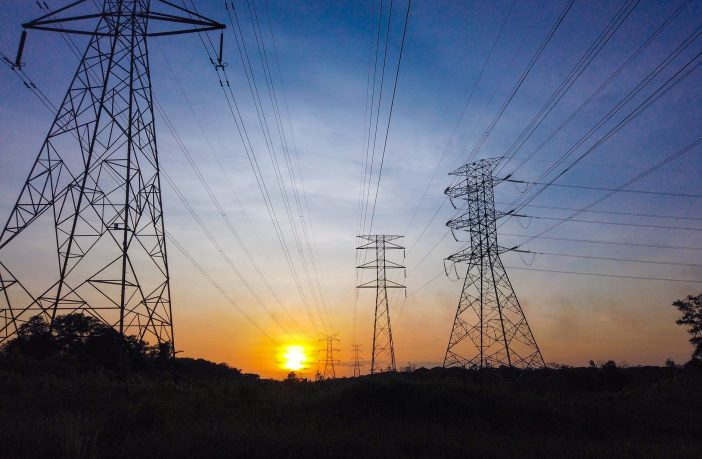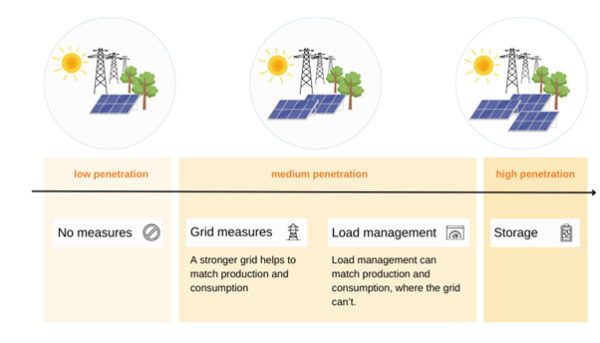Open-Ed
- As the world embraces renewable energy resources, PV Systems hold immense promise for a sustainable energy future.
- However, the challenges posed by the variable nature of PV generation necessitate a reevaluation of how we approach grid infrastructure planning.
- The recently released IEA-PVPS Task 14 report “Active Power Management of Photovoltaic Systems – State of the Art and Technical Solutions” provides a comprehensive exploration of a paradigm shift that could redefine the landscape of distributed PV systems’ integration into the grid.
Low Capacity Factor of PV Systems is a Challenge for the Grid Infrastructure
Distributed PV systems, while largely contributing to clean energy, possess a low capacity factor (ratio of energy output to the maximum possible power output). To ensure continuous power generation, this characteristic necessitates a careful consideration of grid infrastructure, deviating from conventional approaches. Traditionally, grid infrastructure planning revolved around sizing to accommodate power peaks. However, the new PVPS Task 14 report advocates for a fundamental shift towards energy-centric grid sizing. Active power management, e.g. curtailment, and complementary measures can address some of the limitations associated with the intermittent nature of solar energy, making PV a valuable component in the transition to sustainable energy sources.
A Solution for PV Dynamics: Active Power Management (APM)
According to the new PVPS Task 14 report, the key point of addressing the challenges posed by the low capacity factor of distributed PV systems lies in the adoption of Active Power Management (APM). APM, in some contexts also called curtailment, acts as a dynamic control mechanism that actively manages the power flow from decentralized assets to the grid to ensure it remains within operational limits. Unlike passive grid systems that react to fluctuations, APM introduces proactiveness by shaping the power flow based on real-time conditions. This helps to relieve the grid from high power peaks and thus protect them. By combining APM with other grid optimization measures the value of PV-generated energy increases.
Use Cases for APM
APM and, consequently, PV power curtailment becomes necessary in various scenarios. Common reasons for implementing PV curtailment include:
- Local System constraints: Reinforcing the grid connection is often significantly more expensive than curtailed energy. This applies even more if local self-consumption management is implemented.
- Distribution System Constraints: It’s impractical to size a distribution grid for peak PV capacity. PV curtailment can address stability issues during times of high production and low demand.
- Ancillary Service Needs: Power grids require certain ancillary services such as frequency or voltage control. If PV systems are operated in curtailed mode, they could provide these system services.
New Opportunities with APM
One of the primary benefits of APM is the enhancement of grid stability. Of all electrical power sources, PV systems have the lowest capacity factor. To reach the goal of a sustainable energy supply large quantities of PV systems must be connected to the grid and limiting power peaks can reduce stress on the power grid. Whilst traditional grid systems struggle to accommodate the rapid fluctuations in power output from PV systems, APM addresses this challenge by intelligently managing power injections and absorptions, ensuring a stable grid environment even during periods of high variability. When the power peaks are not fed into the grid, surplus electricity can be stored or used for less efficient applications. Using APM, the feed-in can be dynamically ramped up and down.
From an ecological standpoint, it may be advantageous to prioritize the construction of additional photovoltaic systems and operate them in curtailed mode rather than expanding grid infrastructure, given the minimal ecological footprint of PV modules.
Furthermore, as the IEA-PVPS Task 16 study “Firm Power Generation” has previously shown, accepting a certain amount of energy loss by curtailment is also cheaper than installing less PV but adding seasonal storage to the system. However, curtailment is not a goal but rather one method for increasing the utilization of power grids without exceeding their physical limits. It should only be the last option if the PV energy cannot be used elsewhere.
Minimizing Energy Loss
From an energy and environmental perspective, energy loss through curtailment should be limited. Therefore the IEA-PVPS Task 14 report emphasizes the importance of combining APM with complementary measures (see Fig. 1). The goal should be to establish a holistic and synergistic approach to grid management.
Grid measures involve upgrading the physical infrastructure to increase the power capacity of the grid. This may include reactive power control, tap changing transformers or grid reinforcement.
When combined with APM, these enhancements create a grid system that is both intelligent and robust. However, reinforcing the grid becomes redundant if there is insufficient consumption during the production period. It might therefore be essential to shift the load from periods of low production, such as nighttime for PV, to periods of high production. Hence, aligning demand and generation becomes imperative in scenarios with increasing penetration.
Integrating energy storage solutions, such as batteries, into the grid architecture further complements APM efforts. Energy storage serves as a buffer, capturing excess energy during periods of high generation and releasing it during peak demand. This synergy ensures that energy is utilized optimally, reducing wastage and enhancing overall system efficiency.
Proactive Measures for a Sustainable Future
The IEA-PVPS Task 14 report calls for Distributed System Operators (DSOs) to adopt a proactive stance in the face of evolving energy dynamics. Especially in the realm of distributed PV, where energy generation occurs closer to consumption points, DSOs are encouraged to explore and implement APM strategies.
The traditional approach of relying solely on grid expansion to meet increasing energy demands may fall short in the face of the dynamic nature of PV systems. Embracing APM aligns with the evolving needs of a modern and sustainable energy landscape. By actively managing power flows, DSOs can ensure the efficient integration of distributed PV systems, transforming them from potential challenges to invaluable assets for a resilient and efficient energy future.
Author: Bettina Sauer
This article is part of a monthly column by the IEA PVPS programme. It was contributed by IEA PVPS Task 14. Contact Person: Christof Bucher
This article was originally published in pv magazine and is republished with permission.
Disclaimer: The articles and videos expressed in this publication are those of the authors. They do not purport to reflect the opinions or views of Green Building Africa, pv magazine, our staff or our advertisers. The designations employed in this publication and the presentation of material therein do not imply the expression of any opinion whatsoever on the part Green Building Africa concerning the legal status of any country, area or territory or of its authorities.
















